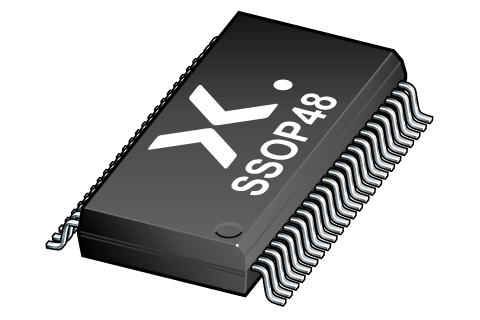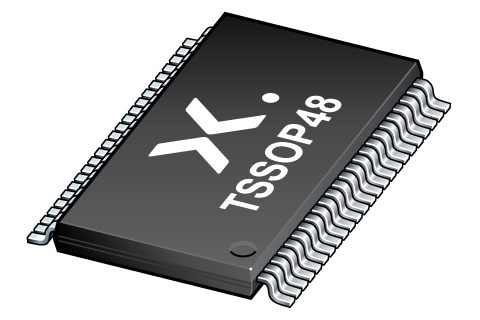
Register once, drag and drop ECAD models into your CAD tool and speed up your design.
Click here for more information74ALVC16244DL
2.5 V / 3.3 V 16-bit buffer/line driver; 3-state
The 74ALVC16244; 74ALVCH16244 is a 16-bit buffer/line driver with 3-state outputs. The device can be used as four 4-bit buffers, two 8-bit buffers or one 16-bit buffer. The device features four output enables (1OE, 2OE, 3OE and 4OE), each controlling four of the 3-state outputs. A HIGH on nOE causes the outputs to assume a high-impedance OFF-state.
Schmitt trigger action on all inputs makes the device tolerant of slow rise and fall times.
This device is fully specified for partial power down applications using IOFF. The IOFF circuitry disables the output, preventing the potentially damaging backflow current through the device when it is powered down.
The 74ALVCH16244 has active bus hold circuitry which is provided to hold unused or floating data inputs at a valid logic level. This feature eliminates the need for external pull-up or pull-down resistors.
Alternatives
Features and benefits
Wide supply voltage range from 1.2 V to 3.6 V
CMOS low power consumption
MULTIBYTE™ flow-through standard pin-out architecture
Low inductance multiple VCC and GND pins for minimum noise and ground bounce
Overvoltage tolerant inputs to 5.5 V(74ALVC16244 only)
Direct interface with TTL levels
IOFF circuitry provides partial Power-down mode operation
Bushold on all data inputs(74ALVCH16244 only)
Output drive capability 50 Ω transmission lines at 85 °C
Current drive ±24 mA at 3.0 V
Latch-up performance exceeds 100 mA per JESD 78 Class II Level B
Latch-up performance exceeds 2500 mA per JESD 78 Class II.A
Complies with JEDEC standards:
JESD8-7 (1.65 V to 1.95 V)
JESD8-5 (2.3 V to 2.7 V)
JESD8C/JESD36 (2.7 V to 3.6 V)
ESD protection:
- HBM: ANSI/ESDA/JEDEC JS-001 class 2 exceeds 2000 V
- CDM: ANSI/ESDA/JEDEC JS-002 class C3 exceeds 1000 V
Specified from -40 °C to +85 °C
Parametrics
| Type number | Package name |
|---|---|
| 74ALVC16244DL | SSOP48 |
PCB Symbol, Footprint and 3D Model
| Model Name | Description |
|---|---|
|
|
Package
All type numbers in the table below are discontinued.
| Type number | Orderable part number, (Ordering code (12NC)) | Status | Marking | Package | Package information | Reflow-/Wave soldering | Packing |
|---|---|---|---|---|---|---|---|
| 74ALVC16244DL | 74ALVC16244DL,118 (935187780118) |
Withdrawn / End-of-life |

SSOP48 (SOT370-1) |
SOT370-1 |
SSOP-TSSOP-VSO-REFLOW
SSOP-TSSOP-VSO-WAVE |
SOT370-1_118 | |
| 74ALVC16244DL,112 (935187780112) |
Obsolete | Not available |
Environmental information
All type numbers in the table below are discontinued.
| Type number | Orderable part number | Chemical content | RoHS | RHF-indicator |
|---|---|---|---|---|
| 74ALVC16244DL | 74ALVC16244DL,118 | 74ALVC16244DL |
|
|
| 74ALVC16244DL | 74ALVC16244DL,112 | 74ALVC16244DL |
|
|
Series
Documentation (7)
| File name | Title | Type | Date |
|---|---|---|---|
| 74ALVC_ALVCH16244 | 2.5 V / 3.3 V 16-bit buffer/line driver; 3-state | Data sheet | 2024-06-11 |
| AN90063 | Questions about package outline drawings | Application note | 2025-03-12 |
| alvc16244 | alvc16244 IBIS model | IBIS model | 2013-04-08 |
| Nexperia_package_poster | Nexperia package poster | Leaflet | 2020-05-15 |
| SOT370-1 | plastic, shrink small outline package; 48 leads; 0.635 mm pitch; 15.9 mm x 7.5 mm x 2.8 mm body | Package information | 2020-04-21 |
| SSOP-TSSOP-VSO-REFLOW | Footprint for reflow soldering | Reflow soldering | 2009-10-08 |
| SSOP-TSSOP-VSO-WAVE | Footprint for wave soldering | Wave soldering | 2009-10-08 |
Support
If you are in need of design/technical support, let us know and fill in the answer form we'll get back to you shortly.
Longevity
The Nexperia Longevity Program is aimed to provide our customers information from time to time about the expected time that our products can be ordered. The NLP is reviewed and updated regularly by our Executive Management Team. View our longevity program here.
Models
| File name | Title | Type | Date |
|---|---|---|---|
| alvc16244 | alvc16244 IBIS model | IBIS model | 2013-04-08 |
PCB Symbol, Footprint and 3D Model
| Model Name | Description |
|---|---|
|
|
How does it work?
The interactive datasheets are based on the Nexperia MOSFET precision electrothermal models. With our interactive datasheets you can simply specify your own conditions interactively. Start by changing the values of the conditions. You can do this by using the sliders in the condition fields. By dragging the sliders you will see how the MOSFET will perform at the new conditions set.
